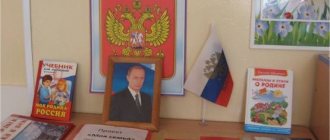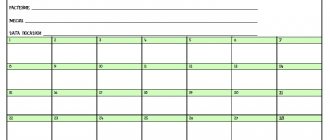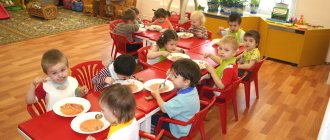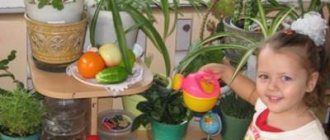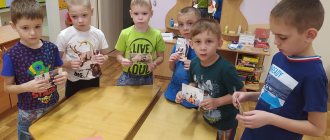Independence and self-care in a child’s life
“Independence and self-care in a child’s life”
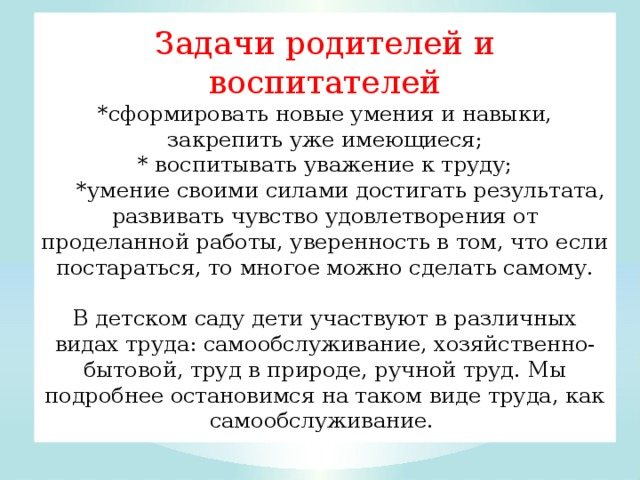
Tasks of parents and educators
*develop new skills and abilities, consolidate existing ones;
* cultivate respect for work;
*the ability to achieve results on your own, develop a sense of satisfaction from the work done, and the confidence that if you try, you can do a lot yourself.
In kindergarten, children participate in various types of work: self-service, household work, work in nature, manual labor. We will dwell in more detail on this type of work as self-service.
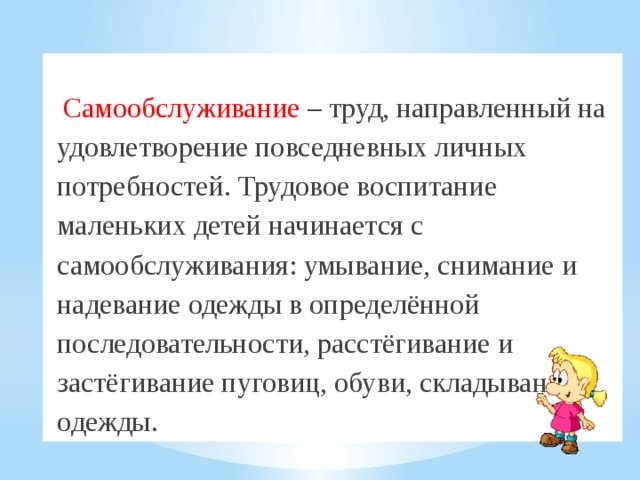
Self-care is work aimed at satisfying everyday personal needs. The labor education of young children begins with self-care: washing, taking off and putting on clothes in a certain sequence, unbuttoning and fastening buttons and shoes, folding clothes.

A child who knows how to look after himself feels good in a group and has more time to play and communicate with peers. Naturally, children do not learn the rules and actions we teach them equally quickly. But every child, with proper upbringing, develops the desire to do everything independently.
And today we will try to show you the significance of this problem, what skills and abilities children should master, and what conditions need to be created at home to facilitate the development of self-care skills in children.
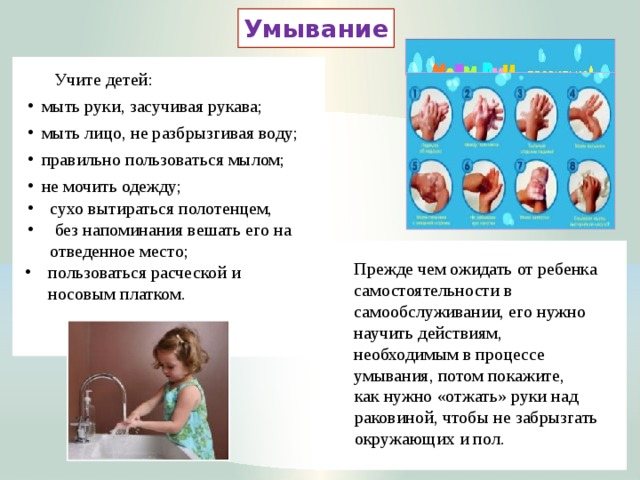
Washing
Teach children:
- wash your hands by rolling up your sleeves;
- wash your face without splashing water;
- use soap correctly;
- do not wet clothes;
- wipe dry with a towel,
- hang it in the designated place without a reminder;
Before expecting the child to be independent in self-care, he needs to be taught the actions necessary in the process of washing, then show him
- use a comb and a handkerchief.
how to “squeeze” your hands over the sink so as not to splash those around you and the floor.
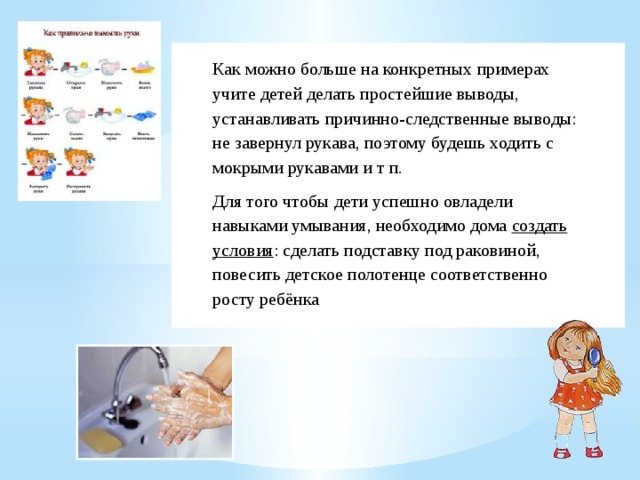
Using specific examples as much as possible, teach children to draw simple conclusions, establish cause-and-effect conclusions: you didn’t roll up your sleeves, so you’ll walk around with wet sleeves, etc.
In order for children to successfully master washing skills, it is necessary to create conditions at home: make a stand under the sink, hang a baby towel according to the child’s height
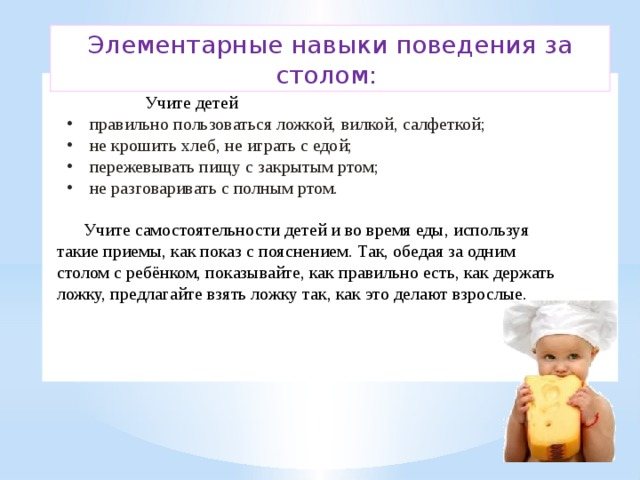
Basic table manners:
Teach children
- use a spoon, fork, napkin correctly;
- do not crumble bread, do not play with food;
- chew food with your mouth closed;
- do not talk with your mouth full.
Teach children independence during mealtimes, too, using techniques such as pointing with explanations. So, when dining at the same table with a child, show how to eat correctly, how to hold a spoon, offer to take a spoon the way adults do.
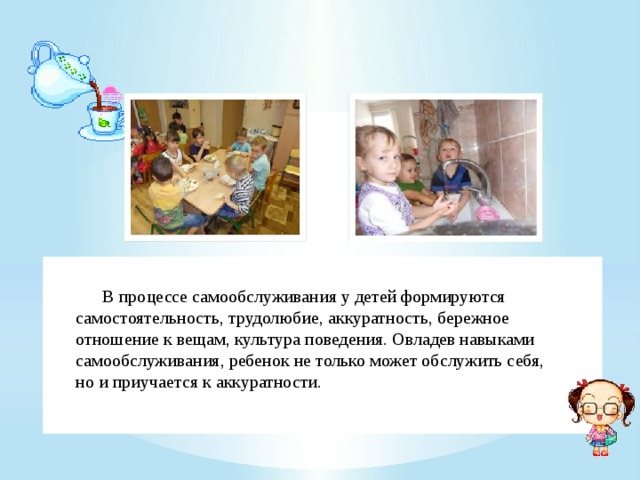
In the process of self-service, children develop independence, hard work, accuracy, careful attitude to things, and a culture of behavior. Having mastered self-service skills, a child can not only serve himself,
but also learns to be careful.

- Dressing
Teach children
- dress and undress independently in a certain sequence (put on and take off clothes, unbutton and fasten buttons, fold, hang up items of clothing, etc.).
Cultivate neatness, the ability to notice disorder in clothing and eliminate it with a little help from adults.
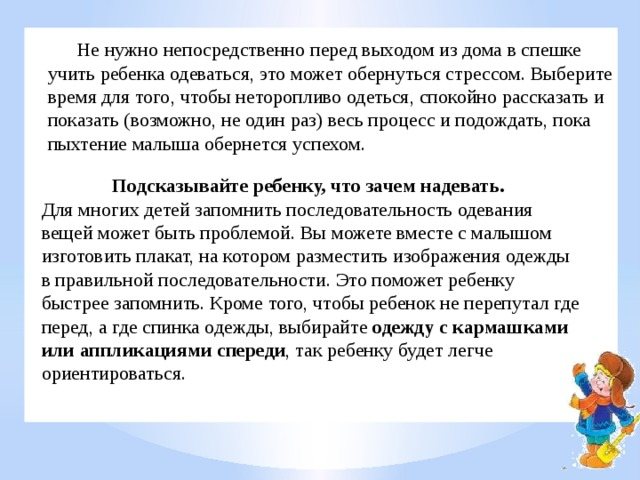
There is no need to hastily teach your child how to dress just before leaving home; this can result in stress. Choose a time to leisurely get dressed, calmly tell and show (perhaps more than once) the whole process, and wait for the baby's panting to turn out to be a success.
Tell your child what to wear and why.
For many children, remembering the order in which to put things on can be a challenge. Together with your child, you can make a poster on which you place images of clothes in the correct sequence. This will help the child remember faster. In addition, so that the child does not confuse where the front and where the back of clothes are, choose clothes with pockets or appliqués on the front
, so it will be easier for the child to navigate.
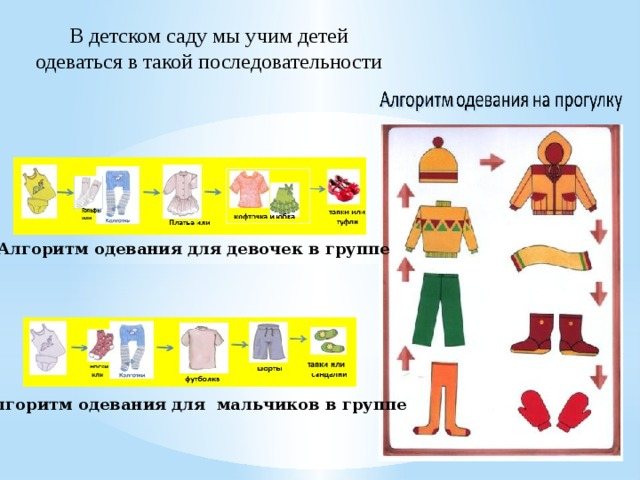
In kindergarten we teach children to dress in this order
Dressing algorithm for girls in a group
Dressing algorithm for boys in a group
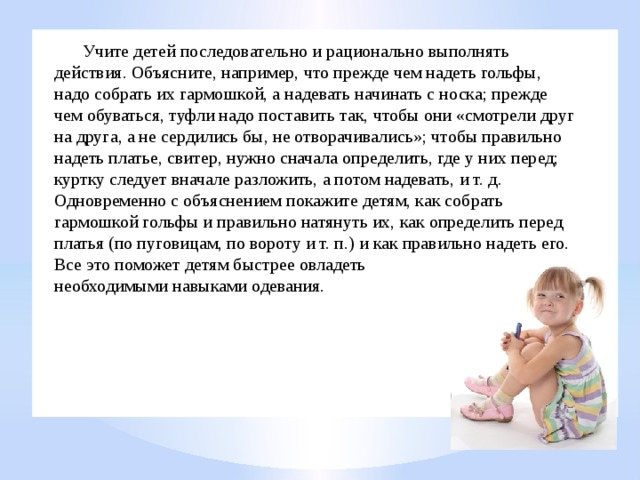
Teach children to perform actions consistently and rationally. Explain, for example, that before putting on knee socks, you need to assemble them with an accordion, and start putting them on with the sock; before putting on shoes, the shoes must be placed so that they “look at each other, and do not get angry, do not turn away”; in order to put on a dress or sweater correctly, you must first determine where the front is; the jacket should first be laid out and then put on, etc. At the same time as the explanation, show the children how to assemble knee socks with an accordion and pull them correctly, how to determine the front of the dress (by buttons, collar, etc.) and how to put it on correctly .
All this will help children quickly master
necessary dressing skills.
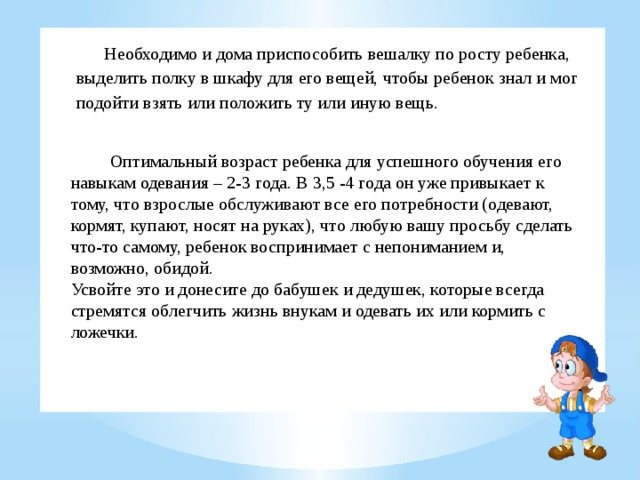
It is also necessary to adapt a hanger at home according to the child’s height, to allocate a shelf in the closet for his things, so that the child knows and can come up to take or put this or that thing.
The optimal age for a child to successfully learn dressing skills is 2-3 years. At 3.5-4 years old, he is already getting used to the fact that adults cater to all his needs (dressing, feeding, bathing, carrying in their arms), and that any request you make to do something himself is perceived by the child with misunderstanding and, possibly, resentment. .
Learn this and convey it to grandparents, who always strive to make life easier for their grandchildren and clothe them or spoon feed them.
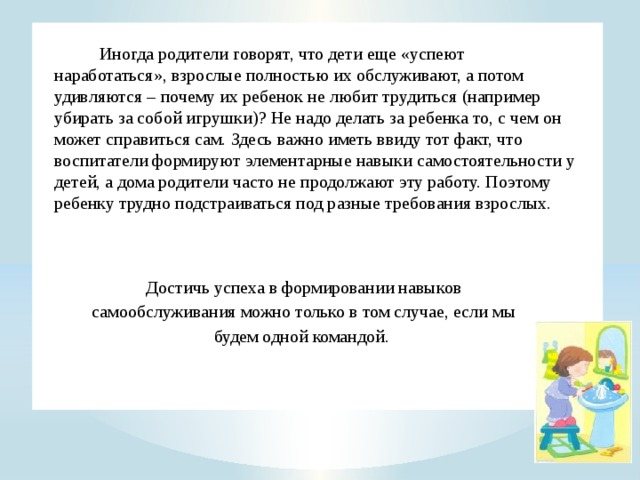
Sometimes parents say that their children will still “have time to work hard”, adults fully serve them, and then they wonder why their child doesn’t like to work (for example, picking up toys)? There is no need to do for a child what he can handle himself. Here it is important to keep in mind the fact that educators develop basic independence skills in children, but at home parents often do not continue this work. Therefore, it is difficult for a child to adapt to the different demands of adults.
We can achieve success in developing self-service skills only if we are one team.
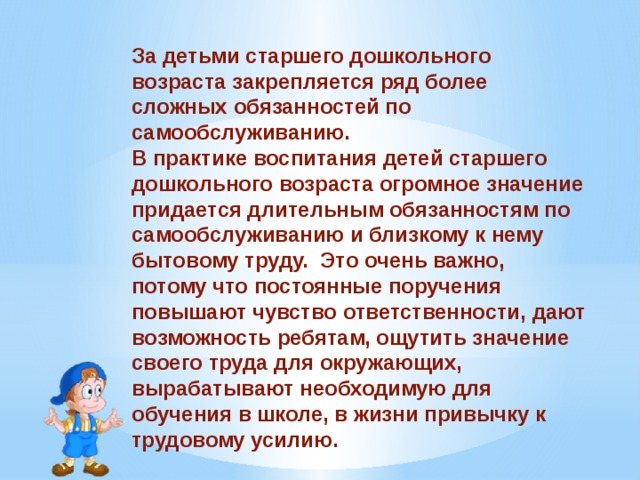
Children of senior preschool age are assigned a number of more complex self-care responsibilities.
In the practice of raising children of senior preschool age, great importance is attached to long-term responsibilities for self-care and related household work. This is very important, because constant assignments increase the sense of responsibility, give the children the opportunity to feel the significance of their work for others, and develop the habit of work effort necessary for studying at school and in life.
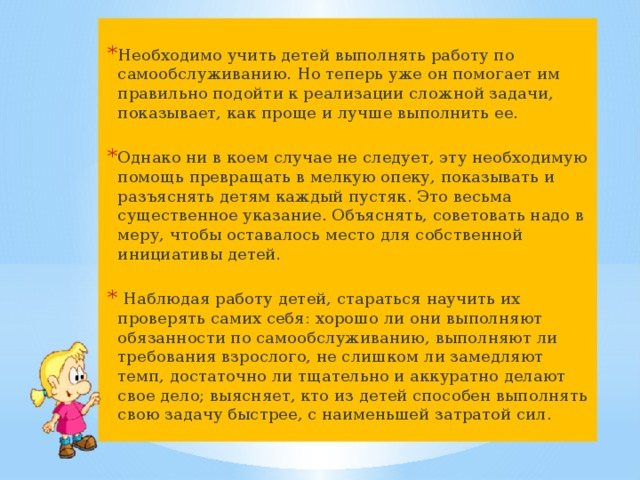
- It is necessary to teach children to perform self-care work. But now he helps them to correctly approach the implementation of a complex task, shows them how to complete it easier and better.
- However, in no case should this necessary help be turned into petty care, showing and explaining to children every trifle. This is a very significant indication. It is necessary to explain and advise in moderation so that there is room for the children’s own initiative.
- While observing children’s work, try to teach them to check themselves: whether they perform self-care duties well, whether they fulfill the requirements of an adult, whether they are slowing down too much, whether they are doing their job carefully and accurately enough; finds out which of the children is able to complete their task faster, with the least amount of effort.
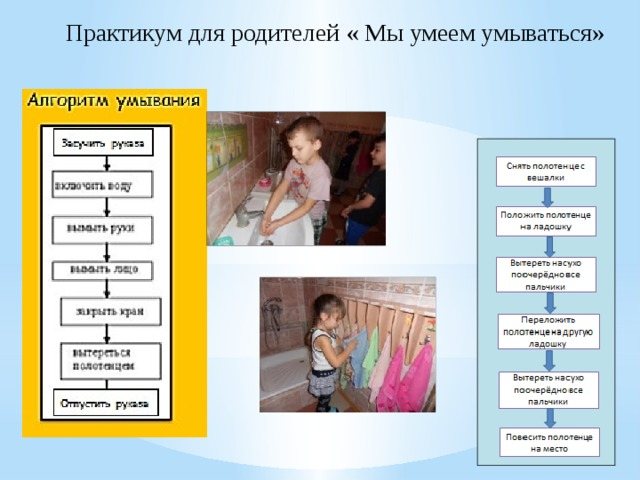
Workshop for parents “We know how to wash ourselves”

Memo for parents
on self-care for preschool children.
Children should be able to:
1. Dressing: dress and undress in a certain sequence: take off clothes, put them on, put your things in the closet, turn them right side out, fasten and unfasten buttons. Notice the mess in your clothes and fix it yourself or seek help from an adult. Use a handkerchief in a timely manner
2. Eating: use spoon and fork correctly. When eating, eat carefully, chew food well with your mouth closed, use a napkin after eating, pull up a chair and say thank you.
3. Washing: wash your face with your hands, rolling up your sleeves, without splashing water. Use soap correctly. Do not get clothes wet.
Dry yourself with a towel and hang it in the designated place without prompting.
4. Clean up toys, books, construction materials yourself
material to a specific place.
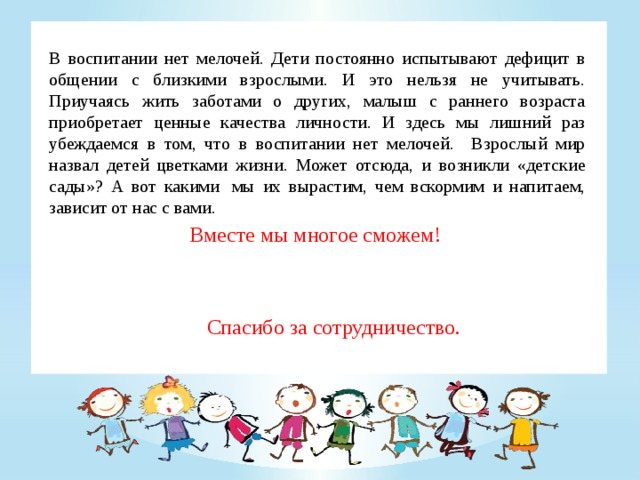
There are no trifles in education. Children constantly experience a lack of communication with close adults. And this cannot be ignored. By learning to live by caring for others, a child acquires valuable personality traits from an early age. And here we are once again convinced that there are no trifles in education. The adult world called children the flowers of life. Maybe this is where “kindergartens” arose? But how we raise them, what we feed and nourish them with, depends on you and me.
Together we can do a lot!
Thank you for your cooperation.
Abstract on the topic Self-service in the middle group
Summary of lessons on organizing self-service for the middle group
Purpose: - to teach children to maintain order in the playroom, bedroom, locker room; promptly and immediately put each thing in its place, help adults and peers in cotton work.
-develop skills independently and with the help of adults and peers, maintain and restore order in the group
- to cultivate diligence, respect for working people: the ability and desire to value one’s own and other people’s work.
Equipment: household items and object pictures, Brownie toy.
Progress of the lesson
The day before, the teacher reads L. Voronkova’s story “Masha the Confused” to the children and conducts a conversation on its content:
-Who is the story about? Who woke up Masha in the d/s?
-Why was Masha late to the nursery one day?
</ -Почему она не смогла найти свои вещи сразу? Где лежали чулки? Где она нашла туфли? Куда было заброшено платье? Где она встретила детей в д/с? Кто виноват, что Маша опоздала?
Educator: -Who keeps order in the house?
- How do you help your mother with this?
-Who keeps order in the group?
-Do you help adults with this? How?
Children: we put toys away, hang clothes in a locker, put them on a high chair before going to bed, put shoes on a shelf, set the table, remove glasses from the table after eating.
Educator: Well done, everyone is attentive and helps maintain order in the group.
We will now go on a tour of the group and see if all the things are in place. If someone does not put the toy back in its place, then the toys may become offended and hide from you.
Teacher: approaches the sports corner and asks the children to name what is missing.
Children: skittles and ball.
Educator: approaches the music corner with the children and asks them to name what is missing?
Children: baskets with rattles
- in the arts and crafts corner - coloring books.
Educator: you see, the children hid a lot of things. But I’ll tell you who can help find them.
You know this hero. This is Brownie, he lives in every house and knows everything that happens in it. The teacher shows the children Brownie and pays attention to his appearance, and says that he is kind, attentive, caring and in his hands he has a bag in which there may be missing toys.
Brownie wants to play with you D/n.
"Wonderful bag"
The teacher calls one child at a time and asks them to take any item out of the bag. The child takes out the object, names it and takes it to its place. After the game, the teacher talks with the children:
-Why should every thing be in its place?
Children: so as not to waste time looking for it and you can take it right away.
Educator: who should keep order?
Children: adults and children.
Educator: you know where each of the things should be. But in every group and home there are many small items and they should also have their place. Brownie offers to play d/i “Every thing has its place”
There are a lot of small items on the table (sewing supplies, pencils, ribbons, hairpins, elastic bands, decorations for dolls) and (boxes, boxes, baskets, cups).
The teacher with the Little Brownie asks one of the called children to find a place for each item. After the game, Brownie rewards the children with stars for their help.
Diagnostics of the results of labor activity in the senior group of preschool educational institutions
The diagnostic card helps the teacher evaluate the results of working with children and sum up the results for the six months. In addition, with the help of this document, the teacher systematizes information and determines what each child has achieved and what he cannot cope with.
The diagnostic card records all types of work activities of senior group students.
Table: example of a diagnostic card
| Author | Savina P.I. | ||
| Development indicators | Actions and tasks | Positive result (the child copes with the task) | Negative result (child fails to complete the task) |
| Motivation | Have a desire to participate in work activities | ||
| Gain the skill of taking a proactive approach to business | |||
| Views of adults' work | Desire to provide all possible assistance to adults | ||
| Attitude to work | Desire to learn about future professions | ||
| Respect for other people's work | |||
| Careful attitude towards the results of your work | |||
| The working process | Careful handling of materials | ||
| Use the most productive work methods | |||
| Finish what you started | |||
| Teamwork | Friendliness and ability to work in a team | ||
| Develop communication skills | |||
| Mandatory | Competently evaluate the results of work | ||
| Have the habit of taking orders responsibly | |||
| Labor in nature | Appreciate and respect nature and its gifts | ||
| Have basic plant care skills | |||
| Know how to plant seeds | |||
| Self-service | Be able to take care of your appearance | ||
| Correct your hairstyle and hair | |||
| Manual labor | Know how to glue cardboard and paper | ||
| Strengthen skills in working with scissors | |||
| Duty | Possess basic table setting skills | ||
| Develop independence | |||
| Household work | Know how to wash things | ||
| Making the bed after sleep | |||
Labor activity is the most important aspect of preschoolers’ education. Children develop the skills necessary for future life in society. The teacher should try to help and guide the child, and instill a love of work. The main thing is not to do all the work for the pupils and allow them to express themselves so that they can fully develop their abilities and potential.


